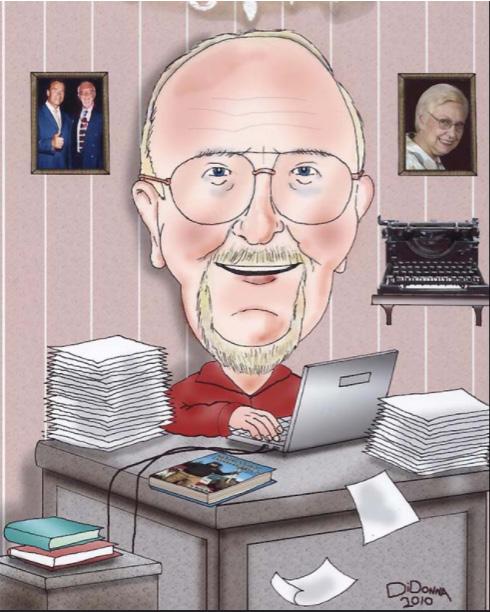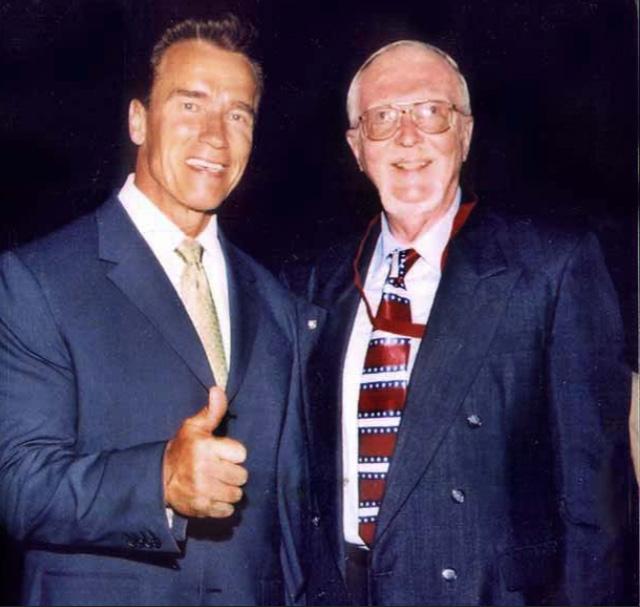
12 minute read
BARRY SCHRADER
A DEKALB COUNTY LIFE
By: Stephen Haberkorn
On June 30, 2020, Barry Schrader’s extensive public and private service to the people of DeKalb County, Illinois came to an end at the age of 79. Schrader had a long career as a journalist, including a 3-year stint as the Editor of the Daily Chronicle. Growing up in both the southern and northern parts of DeKalb County, graduating from Northern Illinois University, and living out his last years in DeKalb at the Oak Crest Retirement Center, Schrader developed a deep love of local history and was committed to ensuring that the notable people, places and events of DeKalb County would be remembered by future generations. Schrader was also an activist, philanthropist and community service leader, who fought to improve the lives of women, racial minorities, and those with disabilities. He leaves behind a legacy of not just his published words, but lives he’s impacted and organizations he helped found or revive.
JOURNALISM CAREER
Barry Schrader said that his interest in history was first kindled during high school when he was hired to scour the back issues of his hometown weekly and prepare a collection of news from 25 and 50 years
before. Those efforts turned into a column called “Looking Back” that ran in the Genoa Republican. Upon graduating with a degree in Journalism from Northern Illinois University in 1963, Schrader edited three weekly newspapers: the Byron Tribune, Stillman Valley News, and Leaf River Register. He then purchased the Genoa Republican and the Kirkland weekly, which was named the DeKalb County Journal. After first starting another weekly publication, the Sycamore Sun, he helped form the DeKalb County Press and bought out the Sycamore True Republican and Sycamore Tribune. Robert Campbell of Genoa, who was a classmate of Schrader at Genoa-Kingston Middle School and High School, said that Barry did a lot of research into anything he took on and was very thorough. He remembers the Genoa Republican when Schrader was the publisher. “It was a great small town newspaper,” said Campbell. “It was all local stuff and things of interest to the town, not to the world.” In 1966, Schrader sold his interest in DeKalb County Press and moved to Southern California to work for the San Bernardino Sun. From 1967-1969, Schrader was the editor of the Livermore (CA) Herald. In 1969, he returned to DeKalb County, Illinois to become the editor of the Daily Chronicle, where he led the paper through their coverage of historic events, such as the Apollo moon landing and the NIU student riots after the Kent State shooting. During this time, Schrader wrote a

weekly column in the Chronicle called “Barbed Wires.” In 1972, Schrader went back to California to serve as editor of the Valley Times (Dublin and Livermore area), and then became editor of the Livermore Herald again from 1973- 1980. After that, he changed careers to become a public information officer and science writer at Sandia National Labs and later served as a community relations manager at Lawrence Livermore National Laboratory (LLNL). He retired in 2006 after serving the last two years as oral historian for LLNL. Upon “retirement,” Barry and his wife, Kay, returned to DeKalb County to be nearer to family, and Barry began writing a weekly column called “DeKalb County Life” in the Daily Chronicle. In his first entry, on December 19, 2007 (“Columnist returns to his roots”), Schrader explained that the column had come about because of a lunchtime conversation with the editor, James A. Bowey. “I had been telling him about the coverage pattern of the Chronicle when I served as its editor from 1969-1972,” wrote Schrader. “We had 25 correspondents, representing all 19 townships in the county. The demographics were much more rural, and the paper felt a need to give attention to every corner of the county, something more difficult now with the county’s 100,000-plus population. As we talked, the idea for a column about those ‘nooks and crannies’ of the county came to life.” In one of his early DeKalb County Life columns, Schrader wrote about the old country correspondents and argued that there should be a monument erected in their honor. “There were thousands of them across the country who filled the inside pages of many a weekly or small town daily with society news, births, weddings and anniversaries, the only way people would ever see their own or a neighbor’s name in the paper and be able to cut out that little clipping and preserve it for posterity in their family album,” wrote Schrader. Schrader said each week in his column he would explore the county to bring the many “people stories” to the readers. Many of those stories would be about his old acquaintances from the 1940s through the 1960s. He said his goal was to write about the people, places and events that make DeKalb County special. Schrader continued those columns weekly or bi-weekly with two breaks, from December of 2007 until February of 2020. All of those columns are available to read on his website: dekalbcountylife.com. He also published two collections of his favorite Chronicle columns, titled “Hybrid Corn & Purebread People,” volumes 1 & 2. At the beginning of the first break he took from the column in September of 2012, Schrader wrote in what he thought would be his last installment, that the column had taken him to all 19 townships and “into countless homes, farms, businesses, and places [he] otherwise would never have visited.” He said that people shared “their life stories, their hobbies, and their family scrapbooks” with him. In effect, Schrader had assumed the role of the old country correspondents.
CHRONICLING DEKALB COUNTY HISTORY
Barry Schrader was about as deeply rooted in DeKalb County as anyone could be. His family went back five generations in the county. He was born on a dairy farm south of Waterman and attended grade schools in Somonauk, Waterman and Sycamore. His family then moved to Genoa, where he completed his middle school and high school education in the GenoaKingston school district. He graduated from Northern Illinois University before beginning his journalism career editing and publishing a number of weekly newspapers throughout Northern Illinois. On top of that, Barry’s wife, Kay, was a Wirsing from Sycamore who also had deep roots in the local farming community.


Schrader’s high school classmate, Robert Campbell, said that Barry was always involved in organizing and starting things. In fact, the summer after they graduated, Schrader organized their first class reunion. They’ve had class reunions at least every five years since and Barry was always involved in planning those. Even when he was living in California, he would make it back for the reunions. Members of the 1958 Genoa-Kingston High School graduating class also continue to meet every other month for brunch. Barry would almost always bring something that he had unearthed to share with the group, such as old photos or high school dance programs. In February of 2020, after Schrader learned of his terminal pancreatic cancer, he had Campbell over to his house to give him a box of photos and memorabilia related to their class. He instructed Campbell to


give the materials to classmates at their next meeting and donate the rest to the Kishwaukee Valley Heritage Society Museum in Genoa. “He saved everything,” Campbell said. This desire to save and preserve memories was a passion for Schrader, and led him to participate in many local and national historical groups. He helped revive the DeKalb County Historical SocietyGenealogical Society, co-founded the Livermore Heritage Guild, and was a member of the Oral History Association and The Fossils, a national organization that preserves the history of amateur journalism. He also wrote a chapter on news media for the book, “Acres of Change, a history of DeKalb from 1963 through 2012,” and videotaped oral histories for the Joiner History Room in Sycamore. During his time in California, Schrader also wrote a book of local lore titled, “Will the Last Person Leaving Livermore Please Unscrew the Bulb in Fire Station One.” Steve Bigolin, a DeKalb County historian who works at the local history room at the DeKalb Public Library, collaborated on numerous projects with Schrader over the years, including installing historical markers to commemorate local stops on the Underground Railroad and researching all of the cemeteries in DeKalb County. “I miss him tremendously, because of his deep-seated historical interest,” said Bigolin. Bigolin first learned of Schrader after reading an “exhaustive” column Schrader wrote in 1972 about Paul A. Nehring’s collection of Abraham Lincoln memorabilia (which was later sold to pay property taxes). When Paul Nehring Jr. died in 1999, Bigolin and Schrader helped his widow, Shirley Hamilton Nehring, go through her husband’s collections at the house at First and Augusta, which is now part of the Ellwood House estate.

“Barry and I, from the moment we first met, really clicked,” said Bigolin. According to Bigolin, the first time Schrader visited his apartment, he couldn’t get over the fact that he possessed an antique wooden school desk. It turned out that the desk was from the old Somonauk Elementary School where Barry attended as a child and where Schrader’s mother taught. “Ever since he saw that desk, he told people that I have his old school desk,” Bigolin said. Bigolin has lost track of how many historical talks he gave that Schrader attended and how many that Schrader gave that he attended. “Every now and then he would give me a call and say, ‘Would you like to go with me here or there around the county?’” said Bigolin. When the local history room in the DeKalb Public Library first opened, Schrader wrote an article for his blog about what a great historical resource Bigolin was and how he could take him just about anywhere in the county—civic area, historic site, building—and he could rattle off names, dates and information about it that would boggle his mind. “[Barry Schrader] had a love of DeKalb County; he had a passion for history,” said DeKalb Mayor and longtime friend of Schrader’s, Jerry Smith. “The guy could just sit down at a typewriter and start pounding out short columns about everything...and he had a passion for attempting in his own small way to involve our young people so that they will have a sense of those who came before them.” Schrader was concerned that local heroes of the past were being forgotten, and advocated for erecting monuments to antislavery fighters like David West of Sycamore who helped smuggle slaves to freedom. “We need to honor the memory and deeds of these pioneers, and not just leave them


on library shelves,” Schrader wrote in his September 24, 2013 column. “Shouldn’t our children and future generations also have physical reminders of the daring abolitionists?” One of the ways Schrader had hoped to pass on knowledge of DeKalb County’s special history was though a “historymobile” that would visit local elementary schools. The idea came to him from the successful “museum on wheels” project that he helped initiate in Livermore, California 25 years prior. “I got the bright idea that DeKalb County children needed a history lesson since they weren’t getting taught much, if anything, about their local heritage in school,” Schrader wrote in a column (“Highs & lows in my golden years”) published July 9, 2013. He tried for five months to gather the support necessary to fund the venture, but the interest just wasn’t there, much to his disappointment.
ACTIVISM & COMMUNITY SERVICE
One of Jerry Smith’s first memories of Barry Schrader back in the early 1960s when they were both on the staff of the Northern Star, the student newspaper at Northern Illinois University, was when Schrader was leading a demonstration on the lawn of what is now Lowden Hall at NIU. The students were demanding, among other things, that women be allowed to wear long pants and that African-American students be able to get haircuts in DeKalb. “These are things that today would be maybe minor issues, but back then were really, really significant,” said Smith. Smith also remembers Schrader being the editor of an underground magazine at NIU called the Quarterback. Leslie Holmes, Bedding Plants � Asparagus � Tomatoes � Homegrown Bi-Color Sweet Corn Cucumbers � Zucchini � Onions � Squash (fall & summer) � Muskmelons Gourds � Peppers � Pumpkins � More
Homegrown and locally grown in-season fruits and vegetables. Taste the difference!
1 1/4 miles East of Somonauk Rd. on Hwy. 38 (815) 756-6005 www.yaegersfarmmarket.com
A DeKalb Fa vorite Since 1956






Voted #1 PIZZA in DeKalb County!
$1.99 ORDER OF VILLA NUGGETS w/purchaseofany LargeorFamilyPizza Value of $5.00. Please mention coupon when ordering. 1 discount per visit. Dine in or carry out only. Expires 2/15/21.






• Pizza • Pasta










Chops DINE 824 DI IN W / CARRY OUT / LINCOLN HWY DELIVERY DEKALB Chicken 758-8116



